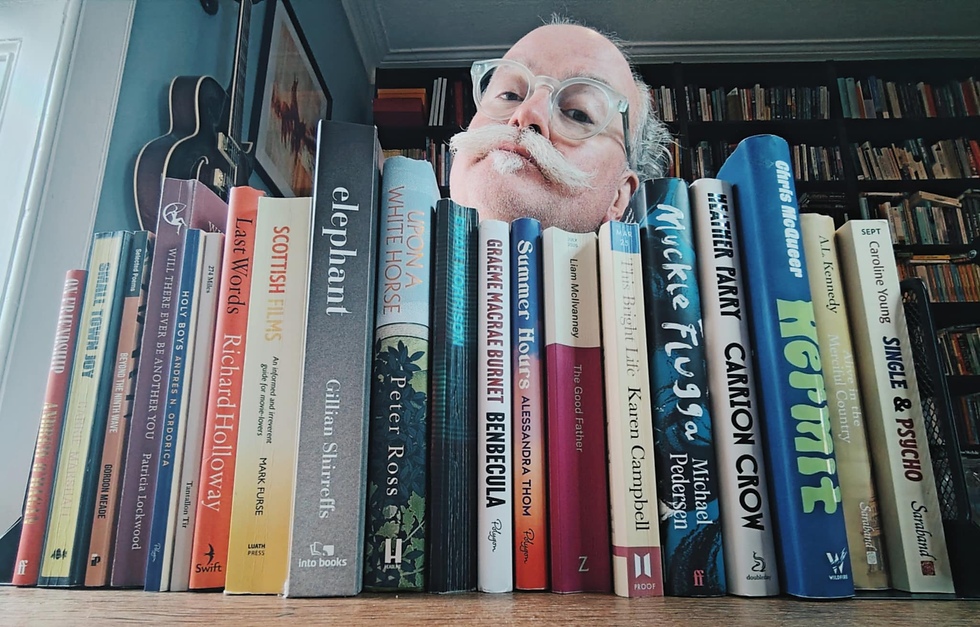Old Morality: A Review Of Charles E. McGarry’s The Shadow Of The Black Earl…
- Alistair Braidwood

- Sep 26, 2018
- 4 min read

One of the most welcome literary surprises of last year was Charles E. McGarry’s novel The Ghost Of Helen Addison. It introduced the world to private investigator, and bon viveur, Leo Moran, whose gift of second sight is both a blessing and a curse. To say this is a Glaswegian gumshoe with a difference is ridiculous understatement writ large. Quite simply, you will never have met a character like Leo Moran. In the SWH! review we said, “With The Ghost Of Helen Addison Charles E. McGarry has presented a new voice to Scottish crime fiction, and a memorable character to match. I’m looking forward to seeing how these novels develop…”. Well, look no further as the man is back in The Shadow Of The Black Earl.
If you liked the first Leo Moran mystery you are going to love this one. After a particularly upsetting funeral the dapper detective goes to stay with his now firm friend, the extravagantly named Fordyce Greatorix, at his family home of Biggnarbriggs Hall. There he encounters a range of eccentric characters who would not be out-of-place in an Agatha Christie novel. What unfolds is a whodunit which delves into the world of the occult, masonic and pagan rituals, and police corruption, as well as touching on every one of the Seven Deadly Sins, and then coming up with a few more. If you didn’t read the previous novel you may think this is business as usual in terms of Scottish crime fiction. You’d be wrong. With this second outing what’s now clear is that Leo Moran mysteries are something entirely different altogether.
One of the most welcome things that McGarry does is to take Leo around the country to solve crimes in Scotland’s lesser known locations. The Ghost Of Helen Addison was set in Argyll, and this time round he finds himself in deepest, and, quite literally, darkest Galloway. It’s an inspired setting which adds an instant atmosphere to proceedings, in no small part due to the rich literary history of the area. Think of the supernatural Border tales of James Hogg, such as The Brownie of Bodsbeck and the epic The Three Perils of Man, and Robert Louis Stevenson’s superb short stories ‘Markheim’ and ‘Thrawn Janet’, as well as his masterpiece of a novel The Master of Ballantrae. All of these have a strong sense of a place where religion and superstition clash, and there is no doubt McGarry taps into this.
But, perhaps surprisingly, it’s another well kent Border writer who I was reminded of when reading The Shadow Of The Black Earl, and that is the Great Waldo himself. It’s not just the place which brings Walter Scott to mind, (he spent most of his time on the other side of the M74, so to speak), or that Briggnarbriggs Hall has more than a hint of Scott’s beloved Abbotsford about it in its grandeur and folly. It’s not even that the title has overtones of Scott’s 1816 novel The Black Dwarf. Comparisons are to be found in McGarry’s writing as well. Going against the grain of most modern fiction, never mind crime, this is a writer who will not be rushed. As with Scott he refuses to hurry matters, enjoying the diversions his characters make along the way. The idea that every sentence has to be a punch, or that action is all, is anathema. Like his protagonist, McGarry would far rather his reader stop and smell the roses.
His descriptions of the surroundings are often extensive, verging on the purple at times, but they completely suit the people and places depicted. In terms of the detective work think of Conan Doyle’s Sherlock Holmes’ novels, or even G. K. Chesterton’s tales of Father Brown. There is something distinctly out of time about the Leo Moran mysteries. In fact it is easy to forget you are in a contemporary novel until mentions of mobile phones and Facebook profiles break the spell. It’s another sign that this is a writer doing something different. You might even think he’s deliberately out to subvert the crime genre. Taking a Glasgwegian PI away from the side of the Clyde is just the start.
There is little doubt that McGarry has developed as a writer from The Ghost Of Helen Addison. This time round there are less detailed depictions of what Leo eats and what he wears, which personally I missed as I love food and clothes, but I think it was the right decision in terms of moving the plot along. More importantly, he makes far better use of his female characters in this novel, his relationship with Elaine central to proceedings. I would love to see even more of Stephanie – the one friend who seems to have his number – as I think they would make a memorable double act. Perhaps that’s being kept for Leo Moran’s third mystery. I certainly hope there is one. A character as ineffaceable and distinct as Leo Moran deserves a long literary life, and that goes doubly for Charles E. McGarry.
The Shadow Of The Black Earl is out now and is published by Polygon Books.









Comments